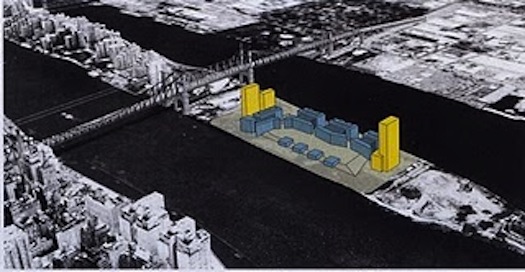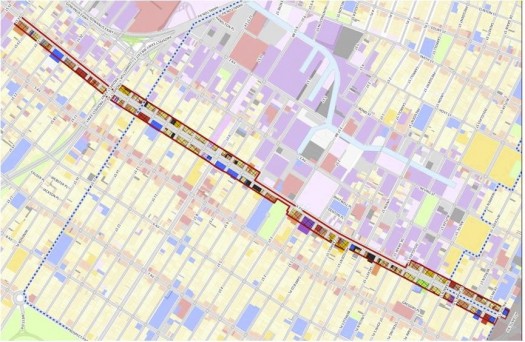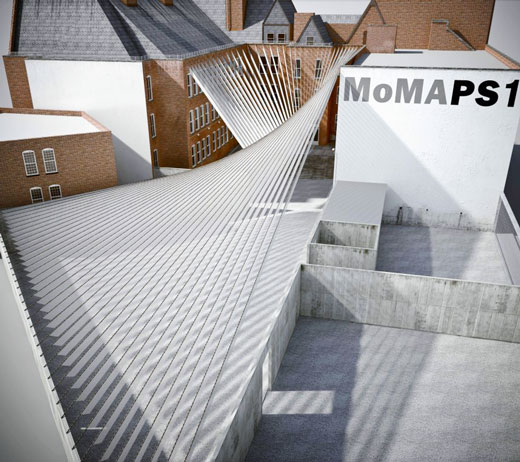
We are celebrating 15 years — and counting — of stories that are deeply researched and deeply felt, that build a historical record of what the city has been.
We are celebrating 15 years — and counting — of stories that are deeply researched and deeply felt, that build a historical record of what the city has been.

Proposed Applied Science and Research Campus | Image via Roosevelt Islander
THE NEXT TECH CAPITAL: NYC
This past March, the New York City Economic Development Corporation (NYCEDC) solicited a request for expressions of interest (RFEI) to global research institutions for ideas to establish a future “applied science and engineering research campus” somewhere in New York City. NYCEDC received 18 proposals from top schools that included designs on four recommended 40-acre sites, including the Navy Hospital Campus at the Brooklyn Navy Yard, the Goldwater Hospital Campus on Roosevelt Island in Manhattan, areas on Governors Island, Farm Colony on Staten Island and some privately owned sites. Stanford University unveiled a particularly interesting plan for an institute on Roosevelt Island, which, if constructed, could open in 2015. Harvard economist Edward Glaeser wrote on the topic for The New York Times, reflecting on whether or not an applied science center in New York City even makes sense. Read Glaeser’s piece here and see the full coverage of the Stanford proposal in The Architect’s Newspaper, here.

Proposed Fourth Avenue Zoning Area | Image via Department of City Planning
DCP PROPOSES ‘ENLIVENED’ FOURTH AVE
The New York Times’ City Room blog covered the Department of City Planning’s latest proposal to rezone the commercial strip of Brooklyn’s Fourth Avenue, between Atlantic Avenue and 24th Street (from Park Slope to Sunset Park), in a effort to ban new developments from constructing parking lots, apartments or any block-long stretches of unfriendly walls on the ground floor. The proposal eliminates streetside parking and residential use, requires “a minimum of 50 percent street wall transparency” on Fourth Avenue, from two feet above the sidewalk up to 12 feet, and calls for all owners to devote at least half the space for retail. After 1993, when it was partially rezoned for residential use, Fourth Avenue began a “visible and dramatic transformation from an auto-oriented, heavy commercial and industrial avenue, to one with a significant residential presence.” The proposal is currently in public review, and will be assessed by affected Community Boards for the next 60 days.

Gotham Greens Greenpoint Greenhouse | Image via Gotham Greens
GOTHAM GREENS: BK GREENHOUSE
Gotham Greens, Brooklyn’s first commercial greenhouse farm facility, will begin their first Greenpoint harvest this month! The hydroponic greenhouse will provide year-round production of vegetables and herbs soon to be sold at a select list of restaurants and retailers in NYC. This hyperlocal commercial facility is another in a string of urban farm businesses including Brooklyn Grange and Eagle Street Farm. Check out Gotham Greens’ site for updates on where you can buy their locally produced veggies in the near future.
WALL STREET JOURNAL: “THE BIKES HAVE WON!”
The Wall Street Journal published an optimistic piece on the city’s ongoing “war” over the value of bike lanes, bike culture and the future of biking in New York City. Author Jason Gay adeptly claims that biking is far from the cultural fringe of our city, asking readers: “Email your friends. Ask how many of them own bikes. Then ask how many of them own cars. If more of them say they own cars, look out the window. You live in Connecticut.” Gay believes the so-called bike war is actually an enormous mischaracterization by the media, and draws salient points about the outcome of the momentum built by bike advocates like Transportation Alternatives and DOT Commissioner Janette Sadik Khan. “The bikes have won and it’s not a terrible thing.”

Amtrak Acela Train | Image via Amtrak
THE END OF AMTRAK?
Last week, Chairman of the House of Transportation and Infrastructure Committee John Mica proposed legislation to privatize Amtrak, denouncing the system’s forty-year track record as a “costly and wasteful Soviet-style operation.” The proposed Competition for Intercity Passenger Rail in America Act hopes to “end the Amtrak monopoly,” involving a competitive high-speed rail network between New York City, Washington, DC and Boston. First the act would transfer ownership of the railroad to the US Department of Transportation, after which the Transportation Secretary would seek bids from private companies “to design, build, operate and maintain intercity passenger rail service, including high-speed rail” in the Northeast Corridor. Check out Infrastructurist’s ongoing coverage of the issue, and see the Chairman’s press release on the proposed legislation here.
CITIES vs. SUBURBS
This week’s issue of The New Yorker includes “Get Out of Town,” a piece by Nicholas Lemann discussing the age-old city vs. suburbs debate that draws on several books to assess the factors behind a successful city. “In the United States right now, after a long run of ‘urban crisis’ (punctuated by periodic hopeful reports of revitalization), cities are viewed positively again,” he writes. Through Richard Florida’s The Great Reset, Edward Glaeser’s Triumph of the City, John D. Kasarda/Greg Lindsay’s Aerotropolis, Doug Saunders’ Arrival City, James S. Russell’s The Agile City and more, Lemann looks at the prevalence of celebrations of urban dynamics in current society and touches on questions still unanswered as we move into an increasingly urban world. Read an abstract of the article here, or pick up this week’s New Yorker on newsstands to read the complete piece.

Rendering of Interboro’s “Holding Pattern” | Image via PS1
TO DO: INTERBORO’S HOLDING PATTERN
This year’s PS1 summer courtyard installation is now open! “Holding Pattern” by the Brooklyn-based Interboro Partners will be on view through September 26 in Long Island City and will act as the environment for PS1’s Warm Up music/performance/sound/dance series every Saturday from July 2nd to September 3rd. As part of the installation, Interboro conducted a survey asking local businesses and organizations what objects they would like to have or most need that they don’t already have access to. Based on the results, the team constructed a set of simple but elegant objects, including foosball tables, lifeguard chairs and a rock climbing wall, all of which will be donated to the neighborhood organizations after the installation is taken down. The hope is that this process will strengthen the connection between PS1 and its surrounding community, a goal that inspired the physical form of Holding Pattern. The undulating plains of rope, taut from wall to wall, create a dialogue between the courtyard and the surrounding environment by integrating without obstructing. Find out more about “Holding Pattern” and the MoMA Ps1 Young Architects Program at ps1.org.
.
The Roundup keeps you up to date with topics we’ve featured and other things we think are worth knowing about.
The views expressed here are those of the authors only and do not reflect the position of The Architectural League of New York.